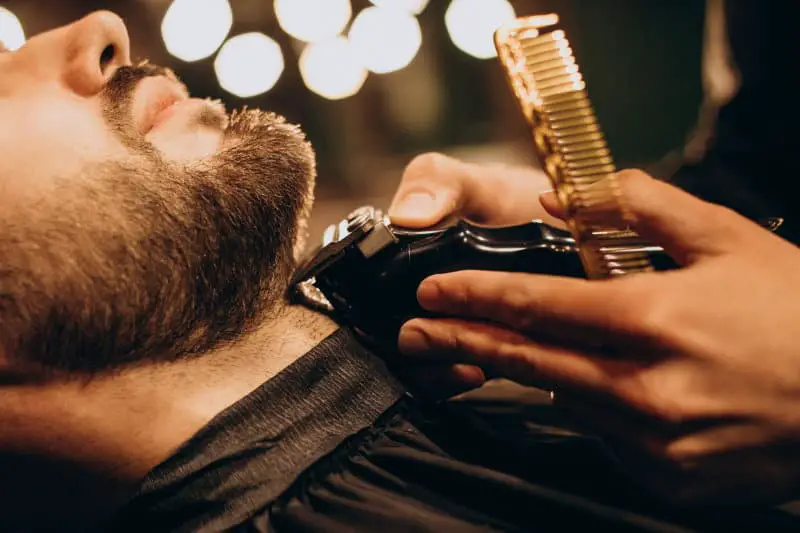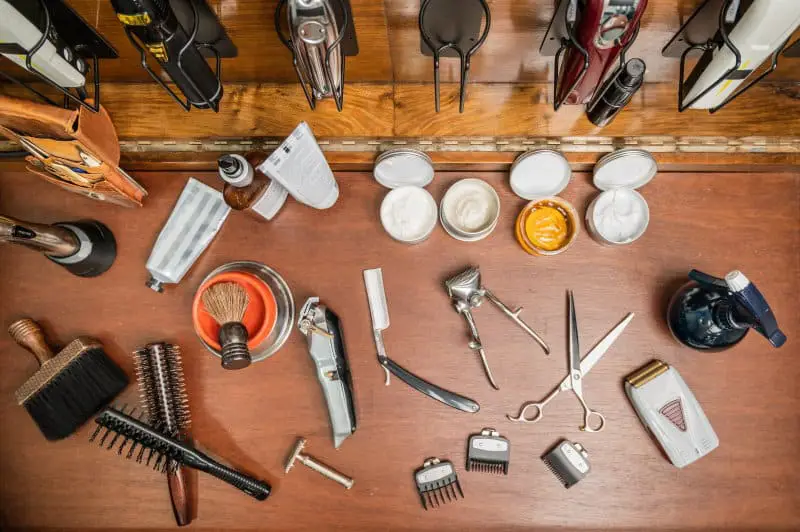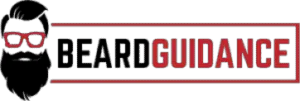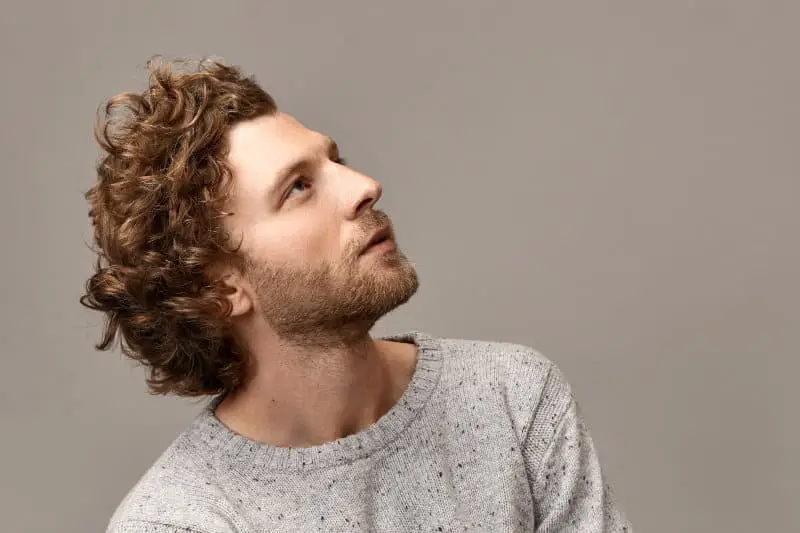Getting a perfectly shaped beard is the result of careful trimming around the edges and shaping the bulk of the beard. The more obvious edges around the cheeks and the sides are easy to get to, but what about the neckline?
As a general rule, to properly trim under your beard, you need to have good visibility. You should also create an invisible border over your Adam’s apple and follow the natural curve of your jaw. Washing your beard makes the hair more flexible and going with the grain minimizes ingrown hairs.
For more in-depth tips on how to properly trim under your beard, keep reading!
How Do You Trim Under Your Beard Properly?

If you’re still starting the process of growing out a beard, you might not be familiar with how to give it a good trim.
While the sides, cheeks, and lip line are relatively easy to maneuver, the underside along the neckline can be a bit challenging for a beginner.
Here are a few tips that can make the process less difficult and easy to repeat every time you need to get rid of that neckbeard:
1. Start With a Freshly Washed Beard
A freshly washed beard will make the next steps a lot easier on you and your clippers. Hair is made of a protein called keratin, which absorbs water and becomes softer and easier to cut once washed.
You should also shampoo your beard thoroughly, as this gets rid of food debris, dust, product residue, and bacteria that might hang out in there.
When you use a razor or clippers, even if you’re very careful, you can still get micro-cuts that can get infected and inflamed.
A clean beard is easier to comb and style, so you’ll know what it will look like once you’re done styling it after the trim.
If your beard hairs are very curly, washing will stretch them out and give you an accurate idea of how long they are.
2. Have the Right Tools on Hand

A sturdy beard trimmer with multiple attachments is your best friend when you’re shaping your beard. But you should also invest in a few other beard-styling tools that will make the job simpler and give you better results.
Wooden beard combs that have fine and coarse teeth can be very helpful in taming your beard hairs and reducing static. Unlike plastic combs that might cause your beard to frizz, wood will glide without causing too much friction and damage to your beard.
A boar bristle beard brush will make detangling a long beard a lot easier and can spread styling products evenly on every strand.
Last but not least, hair-cutting shears are essential for fine-tuning the strays and areas where the trimmer might be too big to reach. Keeping a pair around will make you more comfortable than having to use paper or kitchen scissors!
3. Check Your Visibility
This might seem like an obvious tip, but you should have a large, clean mirror hung where it allows for good visibility. You’ll be moving around quite a bit and you should see your face clearly from all angles.
Avoid a handheld mirror as you’ll be using both hands to hold the skin taught as you trim and shave. And make sure to stand where the lighting is good and won’t create any weird shadows.
Trimming the neckline of your beard can be tricky when you haven’t gotten the hang of it yet. This is why being sure of where you’re trimming will make the margin of error a lot slimmer.
4. Go With the Grain at First
You might be tempted to use your trimmer or razor against the direction of hair growth to get the closest shave, but don’t. This is like taking a high-speed train to ingrown-hair town.
The skin on your neck is quite sensitive. Unnecessary irritation by swiping the trimmer or razor against the grain can cause severe razor burn. It will also force new growth under the surface of the skin.
The ingrown hairs can cause unsightly pimples or red bumps, called folliculitis, that can get nicked by the razor or trimmer the next time you shave. The open wounds can then get infected, and you wouldn’t want that.
When you’re trimming the hair from long to short, go with the direction of hair growth first. This will reduce skin irritation and get rid of the majority of the unwanted neckbeard.
Once you’ve accomplished a shorter length across the border, you can go in against the grain in short strokes to clean the shape even more. Take your time and don’t rush this part, as you’ll want both sides to be even and the border to be straight, not scraggly.
5. Create the Bottom Border

This is a crucial tip that will instantly make the job a lot simpler. As most of us can’t freehand a straight line in the neckline area, why not break it down and make it simpler?
Start with the center point of the line, which you will place just above your Adam’s apple. Don’t extend it beyond or raise it above that point too much as it will make the beard shape less flattering.
Everything underneath this point is your neck, which you want clean-shaven. To complete the bottom border on either side of your Adam’s apple, connect the line with the angles of your jaw, then up to the front of your ears.
Make sure the lines are at an equal distance on either side and avoid going in too deep with the trimmer on the sides. This way you can avoid patchy areas from appearing along the neckline and messing up the bottom border.
6. Shape the Jawline
Your natural jawline and bone structure can be helpful in deciding which shape you should go for.
If you have a strong, square jaw, make the lines to the side more curved. And if you have a softer jaw, make the line more angular and squared off. However, you should avoid ending with a point or a sharp angle as it will look unnatural.
This step will create the illusion of a balanced bone structure and elongate your neck without making the cut-off point too harsh.
If there’s some fat in the chin area, this tip can help you avoid the dreaded “double-chin” look. Just grow your beard long enough that it blurs the line between the chin and the skin behind it, and square the sides of your border slightly to make the softer curve appear stronger.
This works better with darker-colored beards, but a blond or ginger beard can still be convincing. If you want a darker beard but haven’t experimented with beard dye, here’s a guide on how to dye your beard stubble.
7. Clean Your Beard After Trimming
After you’re done trimming the lower border of your beard, there will be a lot of clippings blocking the view of your shaved neck. Hop in the shower real quick or rinse out your beard and neck thoroughly before examining the trim up close.
If there are long hairs or areas with a choppy, uneven line, fine-tune them with your trimmer. Once the center is right above your Adam’s apple and the sides of your jawline are at an equal distance from your ears, you’re done!
8. Apply Good-Quality Products
One thing you should know about growing out your beard is that it’s just like the hair on your scalp; to keep it in place, you’ll need some good-quality products.
Beard products aim to moisturize the hair and the skin underneath it, give enough shine, and create fullness without making the beard frizz up.
This starts with the shampoo you’re using. We recommend using a shampoo catered specifically towards the beard that won’t strip natural oils. Regular hair shampoos usually contain harsh chemicals that can irritate the sensitive skin on your face.
Then comes the conditioner, which you can get in a set with the shampoo or separately. This step softens the hair and moisturizes it, without leaving a residue that can attract dirt and microbes because it’s washed off.
For styling and beard care, there are multiple products you can make use of:
-
Beard Balms/Leave-in Conditioners
A beard balm or leave-in conditioner helps style the hair while moisturizing it and keeping it soft and pliable. You don’t use a lot, just a quarter-sized dollop for a medium-length beard is enough to keep the strays at bay.
These usually have a pleasant scent, but there are unscented options if you don’t like your beard smelling different from your cologne.
-
Beard Oils
Oils are the oldest beard care products out there. People used different oils for their cosmetic properties for millennia, and beards were no exception to this rule.
If you’d like to grow your beard thicker and stronger or would appreciate a bit more shine and softness, beard oil is a great way to start.
Commercial beard oil options are plenty, some are for leave-in use and some should be used as a hot oil treatment before taking your shower.
If you’d like, you can also make your own beard oil at home, which can incorporate different carrier oils like almond, argan, jojoba, and castor oil. You can also add essential oils like tea tree or lavender for even more benefits along with a pleasant scent.
-
Beard Waxes
These typically have more hold and can keep the shape of the beard for longer. If your beard is long with lots of unruly strays, a beard wax can be very helpful. Use them with care, though. You don’t want to end up with a stiff beard
9. Maintain the Trim
They say “Prevention is better than cure,” and in this case, maintaining the trim is better and easier than starting over every time your neckbeard gets longer.
It’s easy if you make a habit out of checking your beard growth. Once the stubble is long enough to shave (usually over 3 mm), just grab your trimmer or razor and get it over with.
This will keep your beard in a presentable shape without too much effort. It will also make the line more definite and easier to follow. When you’re not conflating the short stubble with the longer beard hairs, it takes a shorter amount of time to trim it.
This can also prevent mishaps where you stray from the line and trim too close to the actual bulk of the beard.
Trimming Under Your Beard for Different Beard Lengths

The tips we shared earlier will work for all beard lengths, but as we all know, there are special considerations with different beard styles.
Here’s how to trim under your beard based on how long it is:
Short Beards
- Start with a freshly washed beard.
- Comb your beard hairs against their growing direction.
- Trim your whole beard using longer guards first, then shorter ones till you reach your desired length.
- Remove the guards and use the bare trimmer to outline the neckline. Go with the direction of hair growth.
- If you’d like a close shave on your neck, grab a razor and shaving foam and shave in small strokes against the grain.
- Wash your beard and check for any untrimmed lines.
Medium Beards
- Wash your beard and apply a conditioner, then rinse it off completely.
- Trim the bulk of your beard as usual.
- Use hair shears to trim your mustache and remove any strays.
- With your non-dominant hand, move the beard upwards while holding the skin taught.
- With your dominant hand, hold the trimmer and start from right over your Adam’s apple.
- Trim the neckline with care, going with the grain in short strokes.
- When it’s time to move to the sides, use your non-dominant hand to put the beard away and cover it from the trimmer.
- Make sure the jawline angles on either side of your face are at an equal distance from the center.
- Using a razor to clean up the trim is optional here, but you can do it if you’d like.
Long Beards
- Wash and dry your beard with a towel so it’s not dripping wet.
- Trim your beard as you’re used to, cleaning the cheeks and shortening the sides.
- If you’re trimming the neckbeard for the first time, use a rattail comb to section off the part that needs to be removed.
- Cut the longest hairs with shears at first before using the trimmer.
- For follow-up trims, go with the same procedure as the medium beard.
- If your beard is very long, you might want to clip it up or put it away in a rubber band so the trimmer doesn’t yank off a chunk while you’re trimming under it.
- Wash and dry the neck area from the clippings and style your beard as usual.
Can You Get Away With Not Trimming Under Your Beard?
Trimming under your beard is an essential part of keeping your appearance presentable. This is especially important if your beard extends too far to the side or downwards beyond your Adam’s apple.
For those with a huge difference between their skin color and beard color, not trimming or shaving your neckbeard will be much more noticeable. It’s not very appealing to leave this area untrimmed and will take away from your professional appearance.
It’s highly recommended to keep this area trimmed, if not for aesthetics, for reducing the bulk of your beard and allowing your neck to breathe. If you have a long beard, trimming might not be visible, but you’ll definitely feel the difference it makes.
If you don’t want to go through the whole process, an easier, faster version would be to trim the sides down to meet at the center. This will work with medium-length and long beards, but not the shorter styles.
The process might sound long and tedious, but if you incorporate it into your beard grooming ritual, you’ll get better at it. After practicing for a couple of grooming sessions, it will take no time at all.
Wrapping Up
Trimming under your beard can make a world of difference when it comes to your appearance. This step can help you go from looking unkempt to looking sharp and put-together.
It also completes your grooming routine and makes the contrast between your skin and beard more pronounced.
Just remember to keep the trimming above your Adam’s apple, so you wouldn’t be taking too much from the bulk of your beard. Just be sure to have the right tools and products!
If you’d like to know whether trimming with or against the grain is better for your beard, check out this definitive guide.

